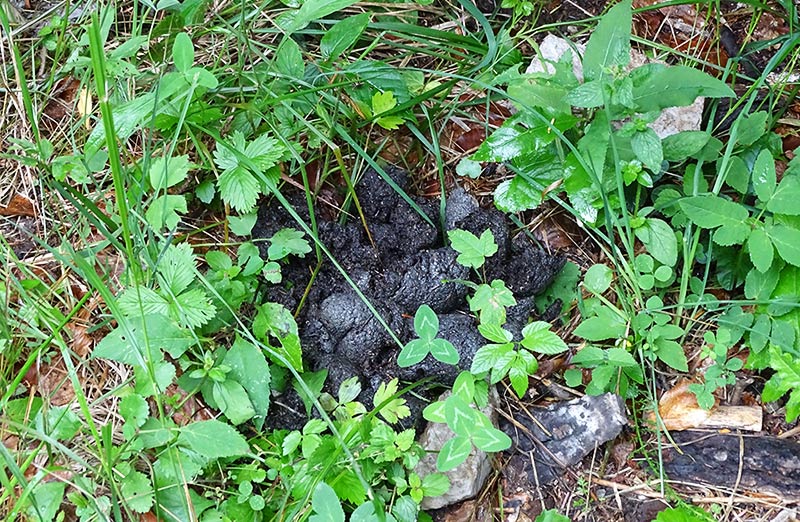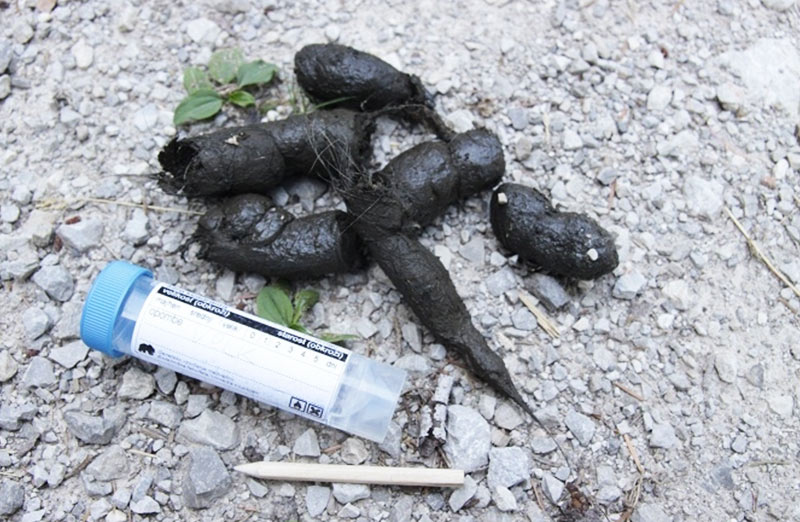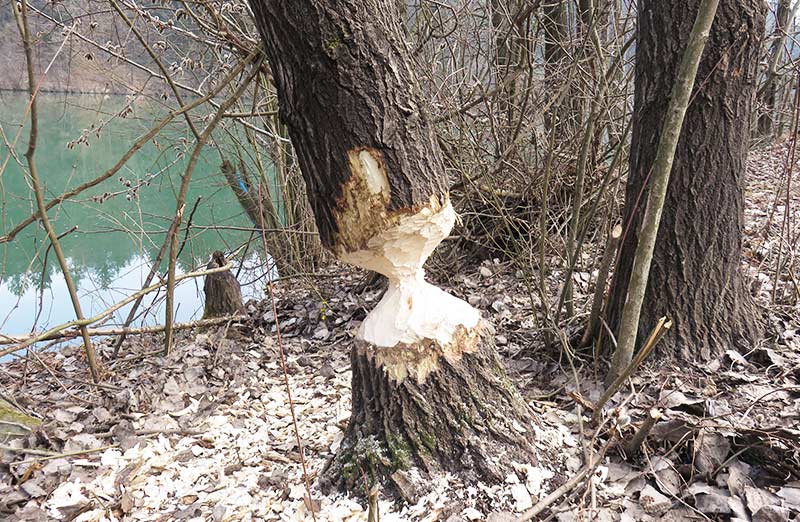Identifying the agent
Brown bear
On the brown bear’s prey, major damage is usually observed: severely damaged or even crushed tissue, bruises, and scratches, as they kill the prey by striking with the front paws. With a larger prey, such as the cattle, the bite scan also be observed. If present, they are usually found on the neck and back. The brown bear eats the internal organs first. The remains of the carcass can be buried or even the dragged aside, even up to 100 m.
When causing damage to the beehives, the main goal of a brown bear is to reach the honeycomb, which is rich in bee brood. To identify the intruder, scratches, footprints and scats should be found in the nearest vicinity of the damage case. If the damage was caused by a brown bear, a true devastation can be found.
The bears also cause damage to the corn. Within the plantation, a suppressed corn in the form of circles can be observed. They prefer the corn, which is still “lacteous”. At this developmental stage, the whole corncob is usually eaten. But when the corncob is completely mature, a brown bears eats only grains.
 photo:
Brown bear scat found at the damage case (archive SloWolf)
photo:
Brown bear scat found at the damage case (archive SloWolf)
In addition to crops and vegetables, brown bears occasionally cause damage to the silage bales, most likely because of the fermentation odor. Since the silage balls are often only torn apart and the grass is pulled out, but not eaten, it is possible that the brown bears are also attracted by the plastic mass of the silage ball protective wrapper. The footprints can be observed on the silage balls, and also in the nearest surroundings. Besides footprints, also scats can often be found.
Wolf
The wolf pack is hunting the prey with persecution. In small groups or even individually, they catch only a small or medium-sized prey. Smaller prey, such as lambs and wild boar offspring, can be killed by the bites over the back. The medium-sized prey, such as small livestock, roe deer, or roe deer calf, is killed with the bite into the neck and throat area. Consequently, the prey is suffocated. Wolves usually kill their prey in only one attempt. On the prey, the bite marks (usually canines), bruises, lacerations, and occasionally scratches can be observed.
Wolves generally do not bite the rest of the prey’s body. In the case of larger prey, such as cattle, horses, donkeys and adult roe deer, the bites in the thighs, hips, and also the back or abdomen can be found. With additional bites, wolves want to stop the prey. At that, meat from the prey’s body can be ripped off and found it the damage case surroundings.
Since there are many misplacements, it is of great importance to distinguish the signs of wolf and dog damage case. Since shorter and less sharp dog’s teeth do not penetrate the skin, in case of the damage bruises are visible under the prey’s skin. With the head and body shaking, dogs cause severe damages to the prey’s throat and neck.
 photo:
Wolf scat sample for genetic analyze (archive SloWolf)
photo:
Wolf scat sample for genetic analyze (archive SloWolf)
Because dogs are usually less trained predators, regardless of the size of the prey, numerous bites are present. Nevertheless, there are highly trained individual dogs, which hunting technique cannot be separated from wolves easily. In such case, the predator can be identified by genetic analyzes. For this analyses, noninvasive genetic samples should be subtracted from the prey. Since they are usually not hungry and hunt only because of the hunting drive, the dogs prey often remains untouched. Such example can occur also after the attack of the wolf pack. When consuming the prey, both species start with the entrails.
Despite the fact that signs of the dogs and smaller wolves killing are quite similar, in case of the damage caused by wolves, the footprints of different sizes can be found. Usually, the number of preyed animals is greater.
Eurasian lynx
The Eurasian lynx hunts usually from an ambush. If the prey is close enough, the Eurasian lynx catches it only by a few jumps. In the prey is not reached in the distance of few ten meters, the Eurasian lynx abandons the hunting. To stop the prey, it usually helps itself with claws. On the prey, deep and sharp scratches can be observed. Since the claws usually do not penetrate the skin, the scraped are found primarily on the upper layers. Larger prey, such as ungulates is killed with a bite in the neck. Sharp canines cause deep wounds without lacerations in the throat and lower jaw area.
They are hard to be noticed at the first place. The bite in the nervous system and carotid artery is the main reason of prey’s death. Less frequently prey dies of suffocation. The rice begins to feed at the thigh, never ingesting the offal. The latter can be found near the prey. When feeding, the lynx pulls the skin towards the head of the prey, so it is usually found inverted outward. It is also important to emphasize, that the Eurasian lynx never tears and takes prey head away. This feeding behavior is observed in fox. The Eurasian lynx feed on prey for several days and covers it with the material found in the nearest surroundings. It can also burry the whole carcass. If the man comes close to the Eurasian lynx’s prey, it does not return to the prey anymore. In the case of damage to the small livestock the Eurasian lynx will not return to the area.
Golden jackal
Signs of golden jackal preying is similar as in dog and fox. Along the body of the prey there are several bites, especially it the abdomen area and on the legs. The Golden jackal begins preying by grabbing the prey and tries to kill it with a side bite in the neck. Since a numerous bite on the body of the prey occur in both dogs and golden jackals, the determination of the predator is reliable only through genetic analyzes. Noninvasive genetic samples, such as saliva, are subtracted from the bite area. Just like other canids (wolves, dogs and foxes), the golden jackals begin to feed on the entrails. The main difference with the fox, is that the golden jackal does not take away the prey’s head.
 photo:
Felled tree by Eurasian beaver
photo:
Felled tree by Eurasian beaver
Eurasian beaver
By building dams and digging tunnels into the coastlines, the Eurasian beaver can cause tree felling and consequent flooding. With various natural building materials (e.g. mud, branches and stones), it can block drains, canals and other water systems, which may further cause damage to the fish farms and also the habitat of other protected species. Digging also cause changes in the urban environment and may lead to the destruction of gardens, walking paths, flooding of roads, pastures and wooded areas. Flooded surfaces are very suitable as mosquito reproduction place.
Since they are fed with them, Eurasian beavers can damage an ornamental trees and shrubs by milling. To prevent damage, the tree plantations should be protected with fences. Damage caused by Eurasian beavers are quickly recognizable and are locally restricted.
Eurasian otter
In addition to the Eurasian beaver, which usually causes damage indirectly, the Eurasian otter directly damages the fish populations. However, the damage caused is not easily recognized. Therefore, the Eurasian otter is often wrongly accused of causing damage. Proper identification of the signs, found at the damage cases, is therefore of great importance. At the damage case, caused by the Eurasian otter, scats can be found near the water, in visible or at marking spots. Also footprints and feeding remains can be observed. The damage can be prevented by deterring or preventing access.

